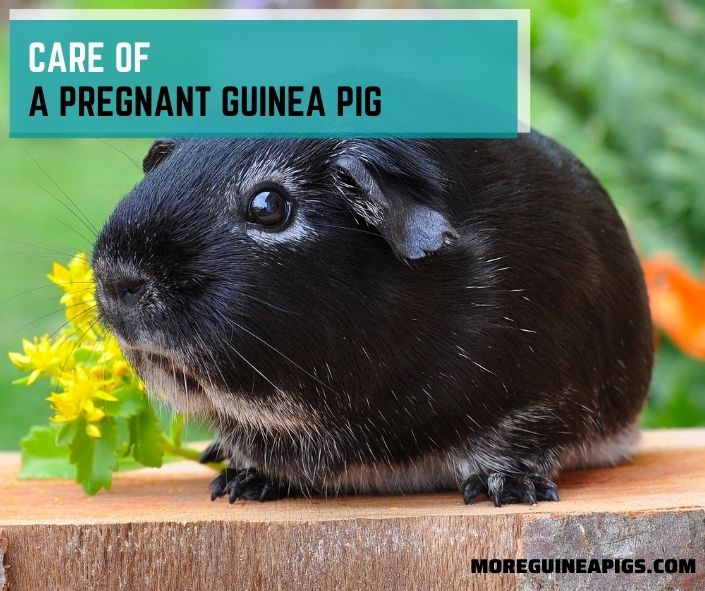8 Disorders and Diseases of Guinea Pigs
Guinea pigs make great family pets, and they are easy to care for. While most guinea pigs are not highly susceptible to diseases, they can develop certain health problems.
If you are keeping guinea pigs, make sure you have adequate knowledge about the health issues your piggies can develop. In this post, we are going to discuss the disorders and diseases of guinea pigs.
Guinea Pig Illness Warning Signs
You can tell if your guinea pig is unwell just by observing the animal. The most common signs of illness include reduced appetite, discharge from the nose or eyes, drooling, diarrhea, lethargy, scratching or hair loss, blood in the urine, lumps, and changes to breathing.
If any of these signs is noticeable, it is important to take action. Depending on the sign and severity, you may need to take the animal to a veterinarian.
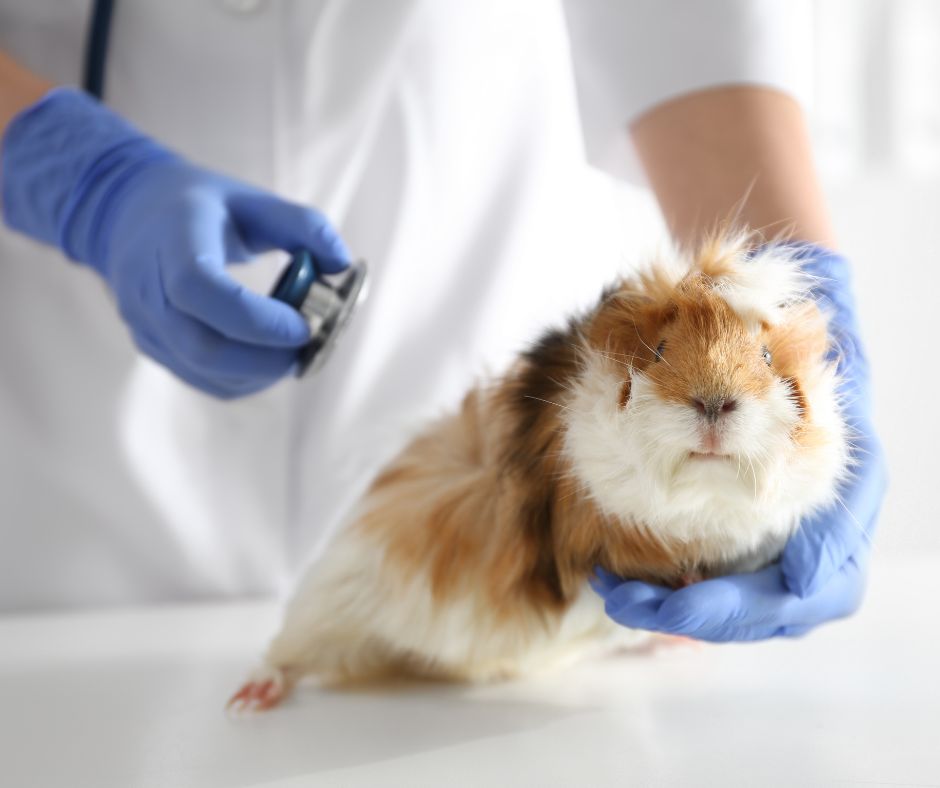
Disorders and Diseases of Guinea Pigs
While disorder and disease are often used interchangeably, there are differences between disorders and diseases.
A disorder is an impairment of a guinea pig’s physiological functionalities. A disorder may be associated with the signs of a disease, but the diagnosis may not be easy due to a lack of clinical evidence.
On the other hand, a disease is a pathological problem that healthcare providers can see and measure.
When diagnosing a disease of a guinea pig, a veterinarian will look for symptoms. Because there are enough clinical findings, diagnosing a disease is relatively easy.
8 Common Disorders in Guinea Pigs
A fair understanding of the common disorders in guinea pigs will make it easier for you to take care of your piggies.
The most common types of disorders are digestive disorders, eye and ear disorders, nutritional disorders such as scurvy, metabolic issues, lung and airway disorders that include pneumonia and adenovirus infection, issues that affect multiple functionalities of the body, and reproductive disorders.
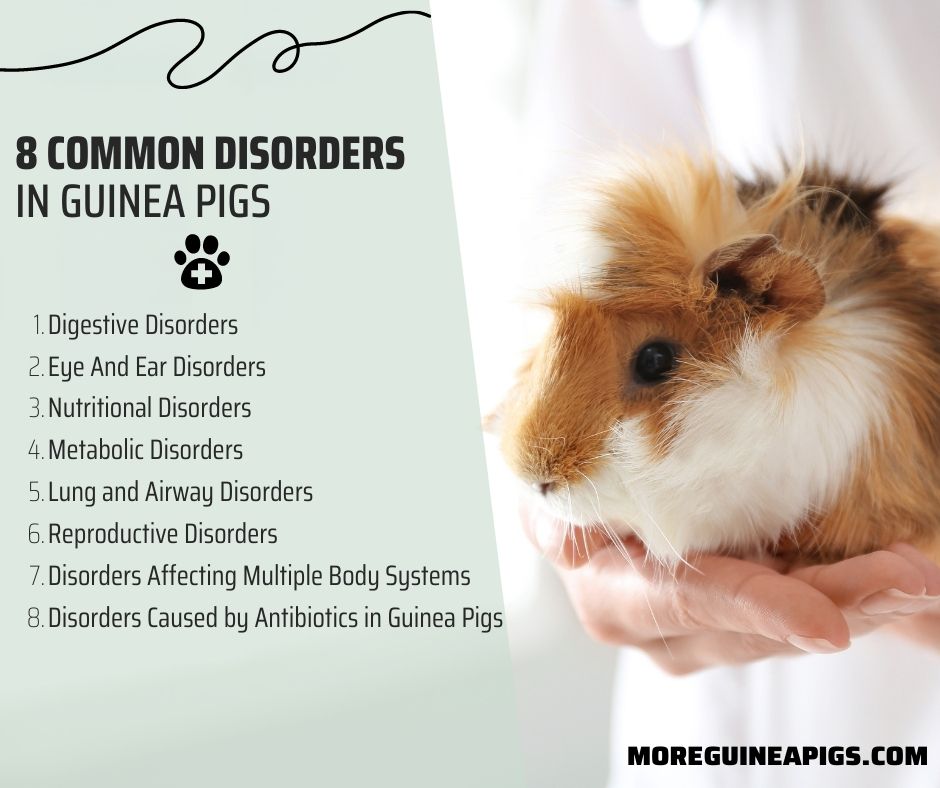
Now we are going to dive a little bit deeper into each of these disorders.
#1 Digestive Disorders
Infections or an improper diet can cause digestive disorders in guinea pigs. The most common sign of a digestive disorder is diarrhea. Different types of viruses, bacteria and parasites can be responsible for this issue.
Other symptoms of digestive disorders include loss of energy, weight loss, dehydration, and lack of appetite. Some guinea pigs show signs such as dull eyes, hunched posture, and rough fur coat.
Without timely intervention, digestive disorders can lead to death. To treat diarrhea in guinea pigs, you should increase fiber and decrease sugars and grains in the diet.
Feed hay to increase dietary fiber. Probiotics can be used to restore the balance of bacteria in the digestive tract.
#2 Eye And Ear Disorders
Pink eye, known as conjunctivitis, is a common disorder in guinea pigs. Signs include crusting, watering and redness of the eyes.
Streptococcus or Bordetella species of bacteria usually cause conjunctivitis. Antibiotics can be used to treat the condition. However, that should be done under the supervision of a veterinarian.
Guinea pigs rarely have ear infections. They usually occur with respiratory diseases such as pneumonia.
Discharge from the ears is the most obvious sign of infection, but your guinea pig may show no symptom at all. If left untreated, the guinea pig may become deaf.
It can also lead to other nervous system problems such as head tilt, imbalance, and walking in circles. Antibiotics are used to treat the disorder, and the type of antibiotic depends on the severity of the problem.
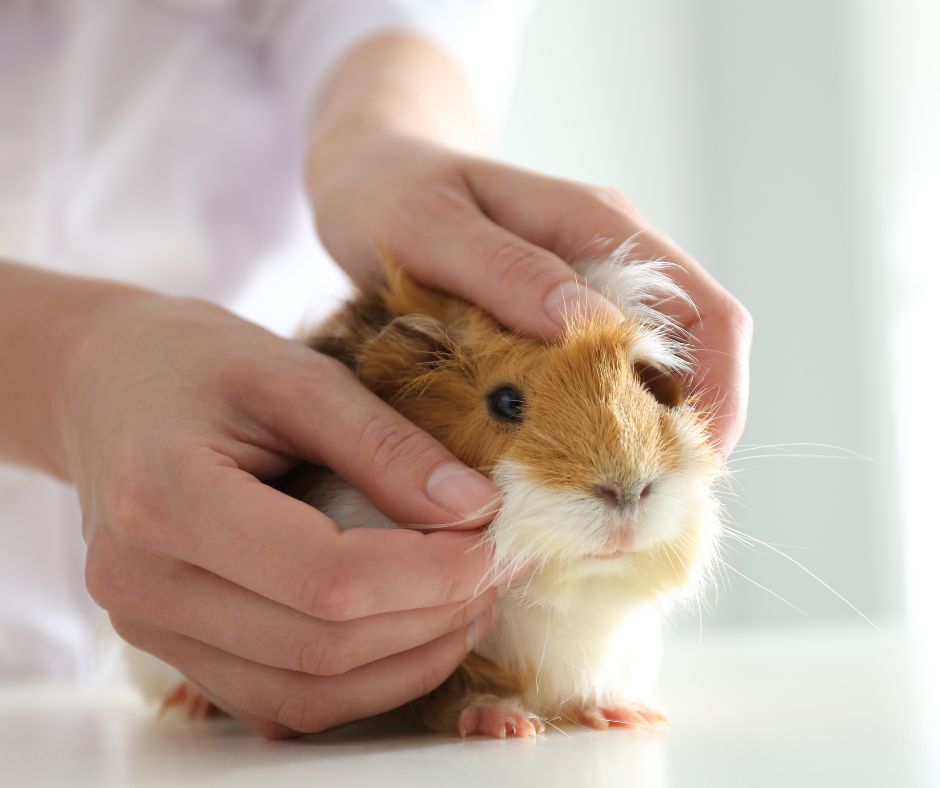
#3 Nutritional Disorders
In guinea pigs, the most common nutritional disorder is a lack of vitamin C. The reason is that these rodents are unable to produce their own vitamin C.
If they do not get enough vegetables and fruits that contain vitamin C, they lose weight, appear weak and lethargic, and have difficulty moving.
Other symptoms include internal bleeding, a rough coat, and a delay in healing exterior wounds. If left untreated, the problem can lead to death.
If you notice the symptoms of vitamin C deficiency in your piggy, get in touch with a veterinary professional immediately.
Besides vitamin C-rich fruits and vegetables, your guinea pig will also need vitamin C supplements. The supplements are given via injection or in pill form.
Appetite loss, which leads to nutritional disorders and weight loss, can result from a host of issues, such as exposure to drafts, recovery from surgery, an inability to chew properly, lack of water.
If left untreated, loss of appetite can lead to liver problems and death.
In order to provide appropriate treatment, talk to a veterinarian. You may need to feed your piggy by a syringe. A critical care diet, pureed pellet diet, and vegetable baby food are usually recommended.
OASIS #80254 Vita Drops-Pure C for Guinea Pig, 2-Ounce, Packaging may vary
#4 Metabolic Disorders
In guinea pigs, the most common metabolic disorder is metastatic calcification—a condition characterized by abnormal metabolism of calcium.
Too much calcium, phosphorus, and vitamin D, and a lack of magnesium in the diet is thought to be the cause of this health issue.
A dangerous thing about this disorder is that it can kill your guinea pig without making the animal appear ill. Male guinea pigs are more susceptible to this disorder than females.
A guinea pig may or may not show signs of metastatic disorder. If signs appear, they include weight loss, increased urination, and muscle or joint stiffness. Prevention is the key. Make sure your piggy gets a balanced diet.
Another metabolic disorder in guinea pigs is ketosis, which is also known as pregnancy toxemia. This condition is characterized by an excessive production of metabolism byproducts.
Obesity, lack of appetite during pregnancy, large litter size, environmental stress, and insufficient exercise are some causes of ketosis.
Pregnant female guinea pigs are especially susceptible to this metabolic disorder. Obesity in both male and female guinea pigs can be a risk factor.
The signs appear suddenly. They include loss of energy, lack of desire to drink, lack of appetite, clumsiness, muscle spasms, and coma. If the animal does not receive any treatment, it dies soon (usually much sooner than 5 days).
A blood test is needed to diagnose ketosis. So, take your piggy to a veterinarian whenever the symptoms appear.
The veterinarian may administer glucose injections and recommend supplements. Emergency cesarean delivery may be necessary for pregnant guinea pigs. But the prognosis is poor and many won’t make it despite treatment attempts.
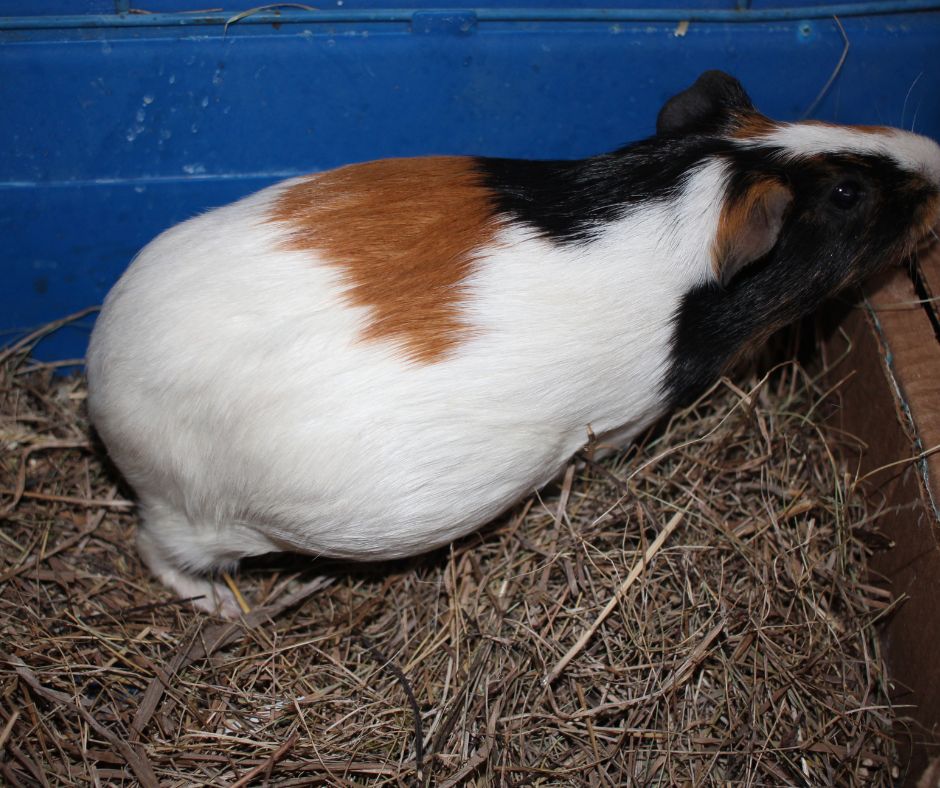
#5 Lung and Airway Disorders
Guinea pigs are susceptible to respiratory disorders, which can become serious pretty quickly. Pneumonia is the most common respiratory disorder in guinea pigs, and usually it is caused by bacterial infection.
Bordetella bronchiseptica, Streptococcus zooepidemicus, and Streptococcus pneumoniae are some bacteria that can cause pneumonia in guinea pigs. A guinea pig may not show any sign of illness even if it is affected by these infectious agents.
Oozing, sneezing, weight loss, fever, loss of appetite, depression, and difficulty breathing are the most common signs of pneumonia.
To diagnose pneumonia, discharge from the nose or eyes is tested. In some cases, performing X-rays may be necessary to diagnose pneumonia.
Pneumonia is treated in a number of ways. Some common treatment options include additional fluid intake, oxygen therapy, and syringe feeding. Antibiotics may be used to treat bacterial infection in the lungs.
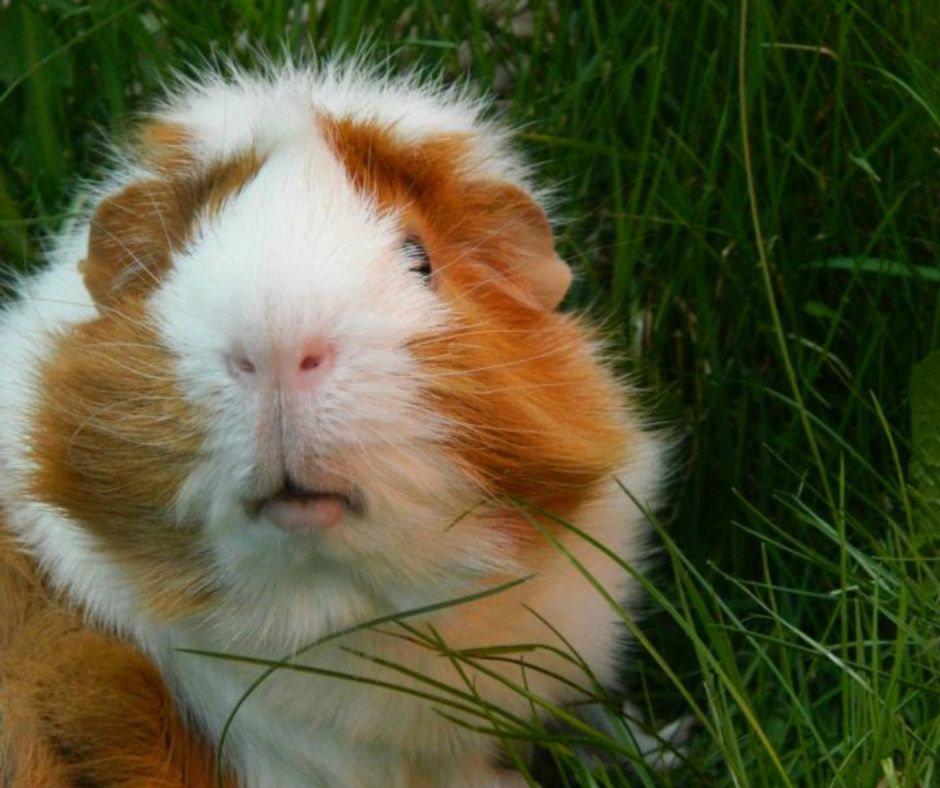
#5.1 Bordetella bronchiseptica Infection
Your guinea pig’s respiratory tract can be affected by another type of bacteria—Bordetella bronchiseptica.
When an affected guinea pig coughs or sneezes, it can transmit this bacteria to others via droplets. This infection is also sexually transmissible.
The signs and symptoms of this disorder include depressed or dull appearance, fever, respiratory distress, loss of appetite, weight loss, nasal discharge, and miscarriages.
The diagnosis of the Bordetella bronchiseptica Infection will require a thorough physical exam of your guinea pig. Your veterinarian may also examine blood samples of the animal.
Antibiotics are used to treat the disorder. Supplementation with injectable or oral multivitamins, and supporting fluid therapy may be required.
#5.2 Streptococcus pneumoniae Infection
Pneumonia can be caused by another pathogenic bacteria called Streptococcus pneumoniae. A guinea pig may suffer from this form of pneumonia without showing any symptoms initially.
Then, suddenly the animal will stop eating, and appear to be stressed. An affected guinea pig can quickly transmit the bacteria to others.
Common symptoms of this disorder include inflammation of the heart, lungs, abdomen or uterus, inflammation of the joints, enlarged lymph nodes, sneezing, respiratory distress, loss of appetite, and dull and distressed appearance.
The issue cannot be accurately diagnosed by just observing your guinea pig’s physical symptoms. A veterinarian will conduct laboratory tests of mucus discharge, urine or blood to confirm a diagnosis.
Antibiotics are used to treat the streptococcus pneumoniae Infection. However, this treatment is not appropriate for all guinea pigs. Supportive therapy with fluids and supplements may be needed.
#5.3 Adenovirus Infection
The guinea pig adenovirus is a subtype of adenovirus, responsible for respiratory symptoms in guinea pigs. Old and young guinea pigs with weakened immune systems are more susceptible to this viral infection.
The incubation period of the virus is 5-10 days. Adenovirus is an asymptomatic infection, which means the infected guinea pigs typically do not show symptoms. However, some symptoms may appear.
They include depression, fever, respiratory distress, loss of appetite, nasal discharge, and crackling sound when breathing.
Laboratory tests on blood samples are required to confirm the diagnosis of this disorder. Treatment can be costly, and may not be very effective. Overcoming the symptoms is the only way out.
#6 Disorders Affecting Multiple Body Systems
Guinea pigs often have disorders that affect multiple body systems simultaneously. These are referred to as generalized or multisystemic disorders. Here are two notable ones:
#6.1 Enlarged Lymph Nodes
Lymph nodes serve the purpose of fighting infection. In guinea pigs, the nodes on the neck can become inflamed or enlarged. A bacterial infection by zooepidemicus is the most common cause of this problem.
The lymph nodes that are infected can become swollen and filled with pus. In some cases, the infection can spread to the ears and eyes.
This infection can spread to other guinea pigs through coughing, sneezing, bite wounds, genital contact, and cuts or scraps in the skin.
Diagnosis of this condition requires laboratory tests. A veterinarian may prescribe antibiotics, but they may not be enough to eliminate the infection. In some cases, surgical removal of the affected lymph nodes may be necessary.
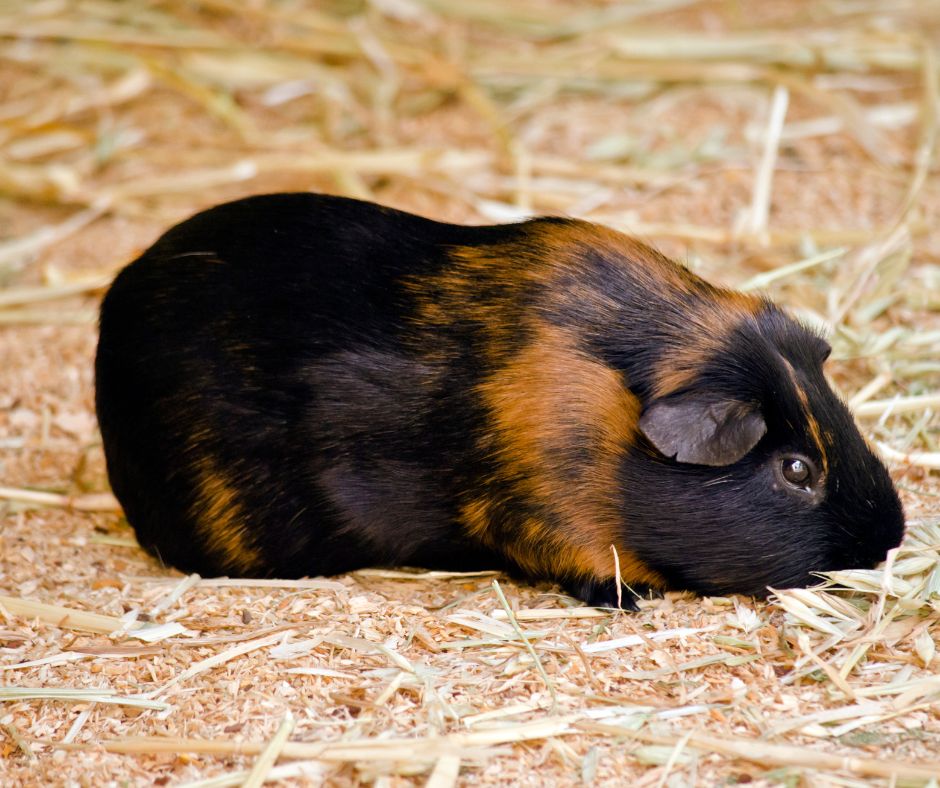
#6.2 Yersinia Infection
Yersinia pseudotuberculosis bacteria is the cause of this disorder in guinea pigs. The infection occurs through contaminated water, food, or bedding.
If the infection spreads to the bloodstream, the infected guinea pig may die suddenly. In some cases, the condition does not cause sudden death.
The animal may develop diarrhea, lose weight, and suffer 3-4 weeks before dying. A bad thing about this infection is that your piggy may not show any symptoms at all, but die suddenly.
The diagnosis of this infection requires laboratory tests. It is important to euthanize the infected guinea pigs and the others that have lived with the infected ones.
Oxbow Essentials Guinea Pig Food
#7 Disorders Caused by Antibiotics in Guinea Pigs
Some antibiotics may have adverse effects on guinea pigs. The medication can directly cause toxic effects or create an imbalance in the gut bacteria.
This problem can be caused by antibiotics such as penicillin, lincomycin, ampicillin, vancomycin, clindamycin, tylosin, erythromycin, chlortetracycline, and tetracycline.
The common signs of antibiotic-induced disorders include loss of appetite, diarrhea, a drop in body temperature, and dehydration. Unless the antibiotic treatment is discontinued, the guinea pig may die in a week.
A veterinarian will test your guinea pig’s feces to diagnose the problem. There is no specific treatment for this condition. You just have to stop the antibiotics and take care of the animal.
#8 Reproductive Disorders
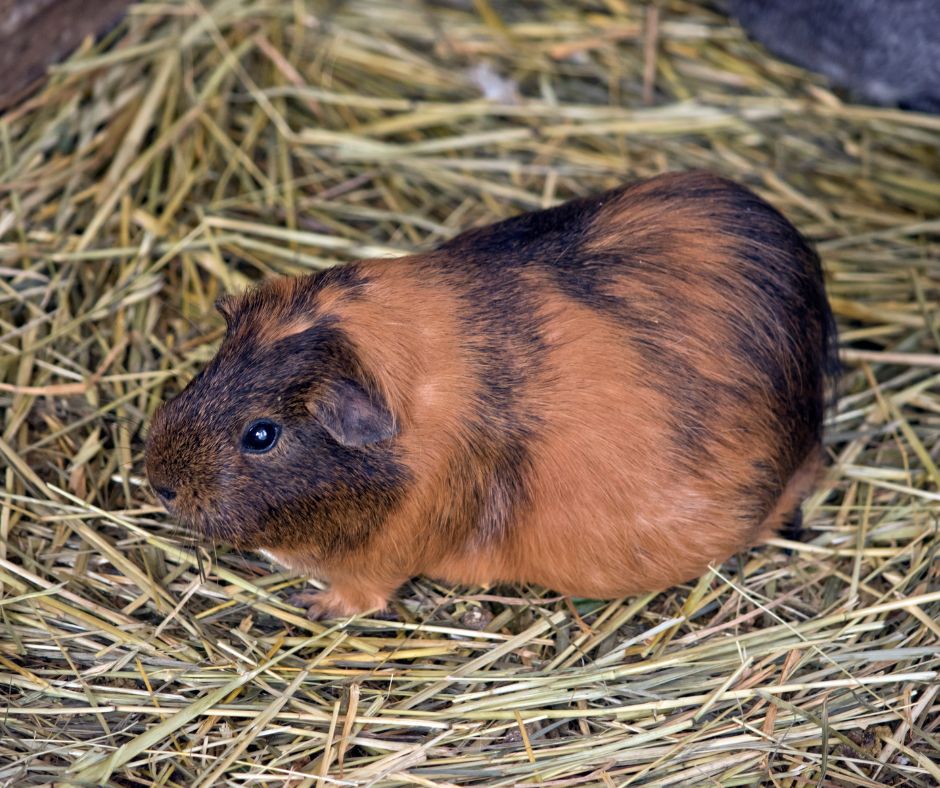
A guinea pig can have reproductive disorders that involve the ovaries, and sometimes mammary glands. Improper calcium levels can cause a metabolic disorder in female guinea pigs during pregnancy.
#8.1 Pregnancy Toxemia (Ketosis)
Ketosis is a metabolic disorder that affects the reproductive organs of pregnant guinea pigs. This disorder is caused by too much production of the hormone ketones. We have already discussed it as a metabolic disorder.
#8.2 Multiple cysts
Female guinea pigs aged over 1 year old are susceptible to ovarian cysts. In general, the cysts affect both ovaries, but only one ovary can also be affected. The signs of ovarian cysts include loss of appetite, hair loss over the abdomen, and loss of energy.
X-rays or ultrasonography is required to confirm the diagnosis. To treat the condition effectively, the affected ovaries and uterus need to be surgically removed. Without timely intervention, the cysts will keep growing, and eventually burst.
10 Common Diseases of Guinea Pigs
Guinea pigs are generally hardy animals that do not require frequent visits to veterinarians. However, these rodents are susceptible to certain health issues.
The most common of these diseases include diarrhea, respiratory infections, tumors, scurvy, urinary problems, skin parasites, foot sores, and abscesses.
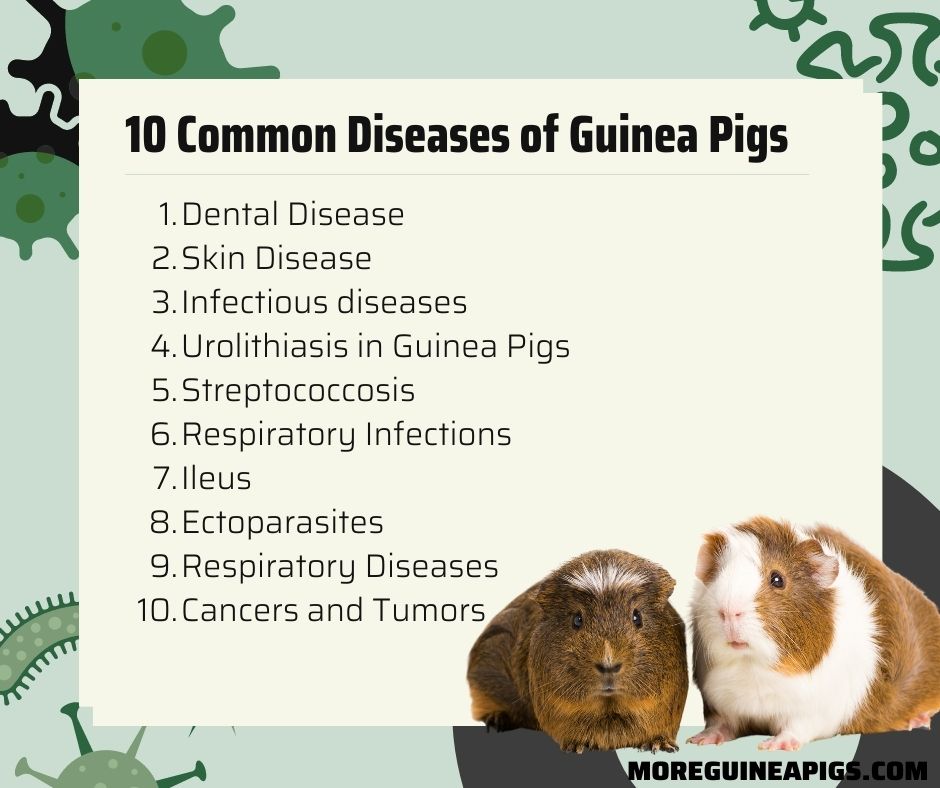
Dental Disease
When guinea pigs have a problem with chewing or swallowing, they drool. This condition is known as slobbers. Improperly aligned teeth, known as malocclusion is the main cause.
But it can also be due to an injury, lack of vitamin C, or insufficient or excessive mineral intake. Malocclusion can cause abscesses in the tooth roots, bleeding from the mouth, or weight loss.
If your guinea pig is drooling or slobbering, take the pet to a veterinarian. The veterinarian may clip some teeth or fill them to align the jaw. To treat the problem properly, regular dental care is necessary.
Skin Disease
Skin diseases are pretty common in guinea pigs, causing itchiness and hair loss. While these diseases are not usually life-threatening, they can cause great discomfort for your piggy.
For every guinea pig owner, learning about the signs and symptoms of different skin diseases is of utmost importance.
Fur Mites
Infestation by fur mites can lead to itching and hair loss. However, the signs may not always appear. It can also happen that your guinea pig loses hair without any visible issue with the skin. Other mites can cause intense itching and skin inflammation.
Shoulders, inner thighs and neck are usually infected by fur mites. The skin underneath the fur may become oily, dry or crusty. If your guinea pig has this issue, the animal will have low energy and lose weight. It may also run around the cage.
If left untreated, this disease can cause death. Fur mites come from other guinea pigs, bedding or other contaminated items.
The proper diagnosis of this disease requires examining the animal’s fur. Topical medications, injections, or both may be used to treat mite infestations.
Lice
Lice infestation is another common health issue in guinea pigs. Your piggy may get lice from other guinea pigs, or from contaminated objects, such as bedding. In guinea pigs, the areas around the neck and ears are usually infested by lice.
If your guinea pig is infested with lice, the animal will show symptoms of distress only when it is under stress. Symptoms of lice infestation include restlessness, intense itching, weakness and anemia, and inflammation around the ears and neck.
Medical checkup is usually not required for diagnosing this condition. Just observing the physical symptoms of restlessness, itching and inflammation may be enough.
To treat lice infestation, parasiticides are topically applied. The type of parasiticide depends on the type of parasite you are targeting.
Ringworm
Ringworm is not a parasite; it’s a fungus. Young guinea pigs are especially prone to this fungus. Other furry animals such as cats, dogs and rabbits also carry this fungus.
If your guinea pigs is carrying ringworm, the animal may not show any sign of illness.
But there are some signs you can look for. The skin can become flaky, dry, itchy, and hairless. You may notice ringworm lesions around the head, face and ears.
You should handle an affected guinea pig with disposable gloves, because ringworm can spread to humans.
Once the condition has been diagnosed by a veterinarian, antifungal medications are used to treat lesions. It is important to disinfect the habitat, toys, beddings, and food bowls of the affected animal.
Hair Loss (Alopecia)
There are a host of possible causes of hair loss in guinea pigs. If they are housed in groups, older ones may show dominance over the younger ones, and chew and tear their hair.
A bored guinea pig may tear its own hair—a condition known as barbering. Alopecia can also be caused by genetic disorders.
Barbering is easy to prevent. Just separate the affected animals from their attackers. If it is caused by a problem in metabolism, or a genetic disorder, talk to a veterinarian.
Remember that guinea pigs shed lots of hair when the coat changes to adult fur. This hair loss is normal.
Pododermatitis (Bumblefoot)
Pododermatitis is another disease caused by Staphylococcus aureus bacteria. If your guinea pig is affected by pododermatitis, the animal’s foot will develop sores, and become inflamed and overgrown.
Obesity, poor sanitation, abrasive cage flooring, and injury are some factors that can aggravate the symptoms.
If left untreated, pododermatitis can cause other complications such as arthritis, swelling of the lymph nodes, and inflammation of the tendons.
It can lead to another condition characterized by an increased production of protein called amyloid in the body. (but rarely)
Your veterinarian will examine the animal to diagnose the condition. In some cases, laboratory tests may be needed. Mild cleansing solutions, antibiotics and pain medications are used to treat this condition.
Infectious diseases
Guinea pigs of all ages can be affected by bacterial, viral, parasitic or fungal infections. Here are some common infectious diseases:
Bacterial Infections in Guinea Pigs
Guinea pigs with weak immune systems are more susceptible to bacterial infections.
While they can be affected by many different types of bacteria, the most common ones are Salmonella enteritidis and Salmonella typhimurium that can spread via airborne particles, direct contact, and contaminated objects and food.
Infected guinea pigs may stop eating, have discharge from the nose and eyes, sneeze, and have trouble breathing. Guinea pigs with nutritional deficiencies, pregnant sows, weanlings, and old ones are particularly vulnerable.
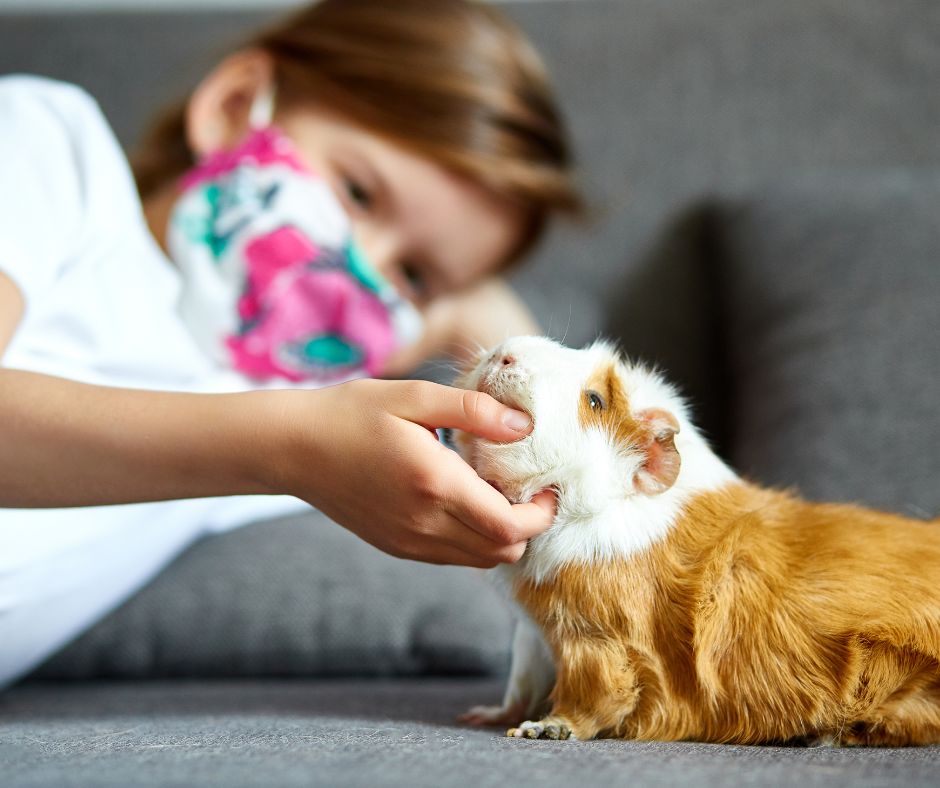
Viral Infections in Guinea Pigs
Guinea pigs can be affected by a specific type of adenovirus. It is an enveloped DNA virus responsible for respiratory diseases in guinea pigs.
Typically, this virus causes pneumonia, but your piggy may carry this virus while showing no symptom of illness.
If symptoms occur, they are typical symptoms of pneumonia—discharge from the nose, breathing difficulties, and weight loss.
Too young or old guinea pigs with weak immune systems are more susceptible to this infection. This virus is not deadly, but in some cases, the infected animal may die without showing any sign of illness.
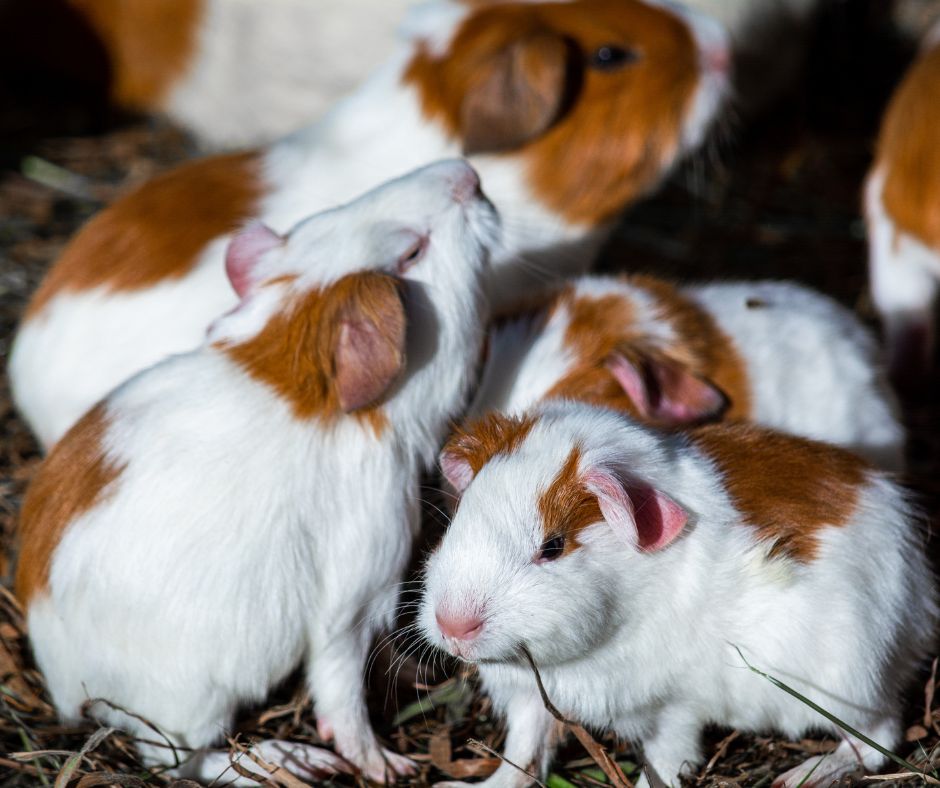
Parasitic Infections in Guinea Pigs
Guinea pigs can be infected by several types of parasites: ringworm, mange mites, lice and ear mites. By looking at the signs, you may be able to tell if there are parasitic infections.
Ringworm weakens hair follicles and eventually causes hair loss. This parasite is contagious to humans. It appears on the facial areas, and the skin underneath looks crusty.
Psoroptes cuniculi or ear mites usually attack the inner ear and cause inflammation. Your guinea pigs may scratch the ear vigorously and shake the head.
Mange mites cause itching, skin lesions and hair loss. These microscopic parasites can cause severe illness, sometimes seizures that can lead to death.
Parasitic infections are usually diagnosed just by observing the symptoms, but sometimes laboratory tests are required. Depending on the type of parasite, your veterinarian may prescribe.
The parasite is treated with n anti-parasitic. These other medicines such as antibiotics, antifungal cream or shampoo would only be needed if secondary issues have developed
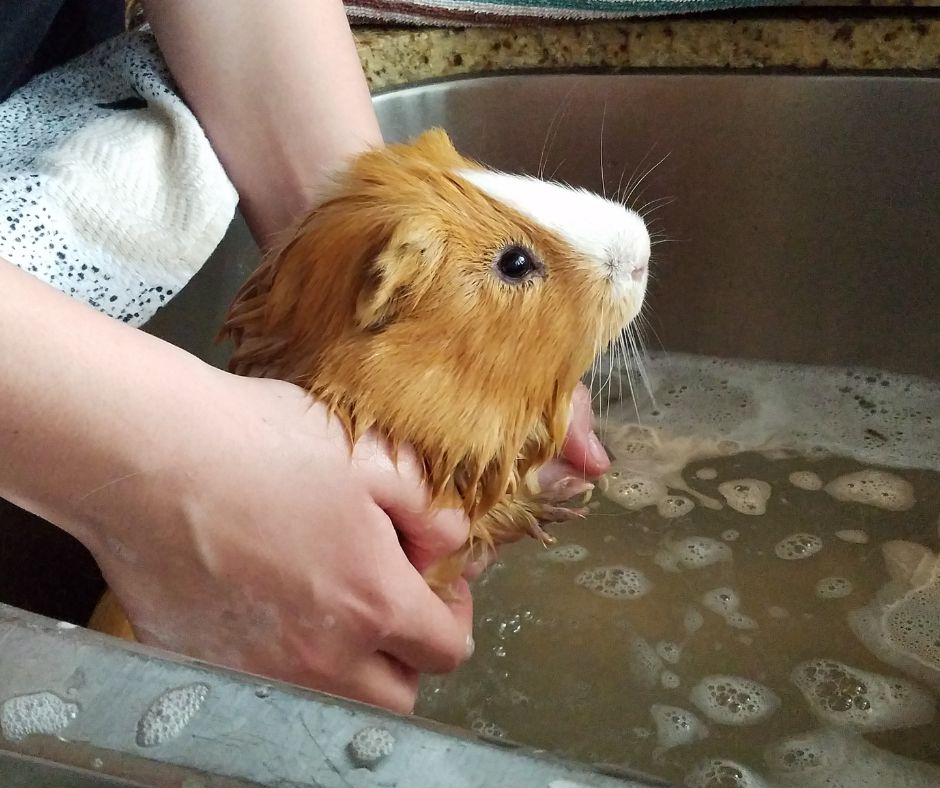
Fungal Infections in Guinea Pigs
A fungus called trichophyton mentagrophytes, also known as ringworm, causes infections in guinea pigs, particularly young pigs.
Lesions appear around the head area, and that area rapidly loses hair. In severe cases, this fungus spread to other areas. It can also be transmitted to humans.
You can diagnose fungal infections in guinea pigs just by observing the signs and symptoms. However, for appropriate diagnosis, laboratory tests are required. Treatment options include ointments, washes, and oral preparations.
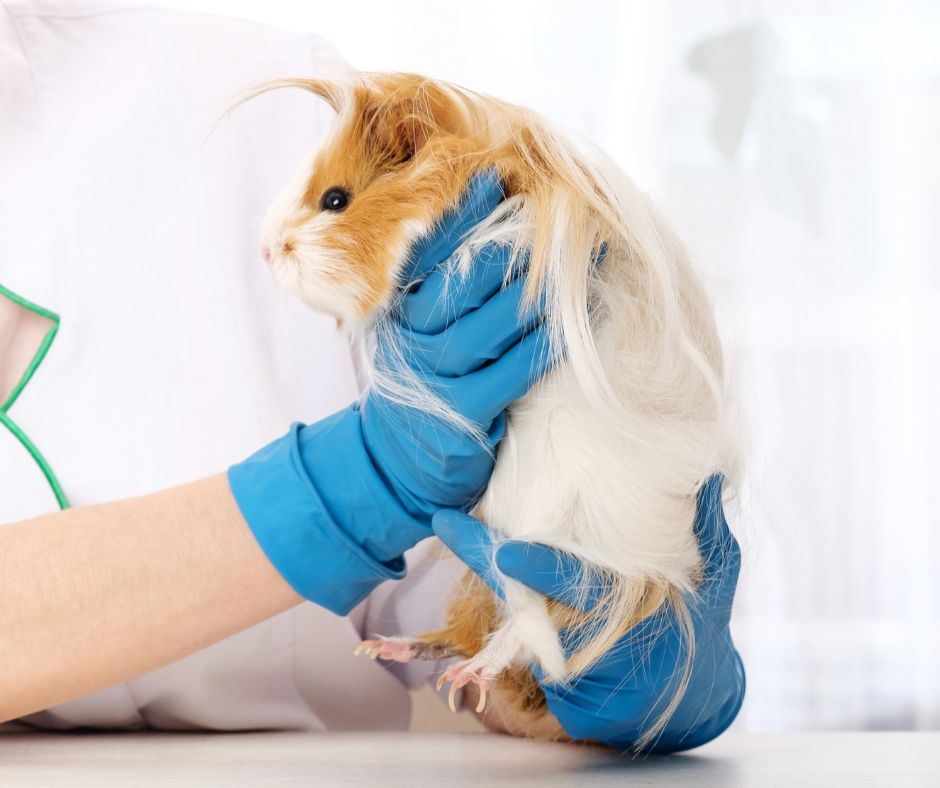
Urolithiasis in Guinea Pigs
Bladder stones, known as urolithiasis, are common in guinea pigs. These stones are salts that contain calcium oxalate, calcium carbonate, and calcium phosphate. The most prevalent of them is calcium oxalate.
A diet containing too much calcium is the primary reason behind this health issue. Bleeding in the bladder, inflammation or infections can also contribute to stone formation.
If your guinea pig has a urolith, the animal may have a painful abdomen, urinate blood, or may not urinate at all. The urine may look white.
Reducing dietary calcium is necessary for reducing the intensity of the problem. The treatment may require surgically removing the bladder stones.
Streptococcosis
Streptococcus pneumoniae bacteria causes pneumonia in guinea pigs. The condition is known as streptococcosis. Your guinea pig may carry this bacteria without seeming sick.
It can cause illness all of a sudden, when your guinea pig stops eating and becomes stressed. This sudden illness can lead to death.
The signs of streptococcosis are those of pneumonia: wheezing, coughing, difficulty breathing, and discharge from the nose.
If left untreated, the infection can spread to the middle ear, causing inflammation and a head tilt. Antibiotics are used to treat the infection.
Respiratory Infections
In guinea pigs, respiratory infections can be caused by several different types of bacteria. The most common of them are Bordetella and Streptococcus.
It is to be noted here that even if your guinea pig carries these organisms, the animal may not show any sign of illness.
The symptoms usually appear when the guinea pig is ill with other diseases, or just stressed. Poor nutrition, moving to a new house, or living in an overcrowded habitat are some factors that can cause stress in guinea pigs.
These bacteria can spread through the air, by direct contact, or via contaminated food. If your piggy has difficulty breathing, talk to a veterinarian.
After accurately diagnosing the cause of the respiratory problem, the veterinarian may prescribe antibiotics.
Ileus
Ileus or gut stasis is a common disease in guinea pigs. When it occurs, the gastro-intestinal tract ceases to move. It leads to problems with digestion, because food cannot pass along the gastro-intestinal tract. And within the gut, harmful bacteria proliferates.
That causes severe pain and bloat. This condition can also lead to liver failure, anorexia, and dehydration. Other symptoms include diarrhea, decreased fecal production, and decreased activity.
Just observing the symptoms may not be enough to diagnose ileus. X-rays and blood tests may be needed.
The treatment for this condition involves using antibiotics, pain medications, and dietary therapy. Oral water intake is encouraged, because rehydration is the key to the treatment.
Ectoparasites
Guinea pigs can get lice, fleas and mites that cause itchy skin and eventual hair loss. This disease is referred to as ectoparasites.
It is to be noted here that all guinea pigs have fur mites that do not usually cause any problem. These mites bother their host only when the host is stressed or has a decreased immunity.
Fur mite infestations can be prevented or minimized by maintaining regular cleanliness of your guinea pig’s living quarters.
In most cases, veterinarians can diagnose ectoparasites by just looking at the affected guinea pig’s fur. But sometimes microscopic laboratory analysis may be required.
The treatment usually involves the application or a powder or spray to the affected guinea pig’s skin. If the disease is severe, a series of injections will be needed.
Respiratory Diseases
Guinea pigs are sensitive to respiratory infections. A minor sniffle or sneezing may not be minor at all; it may lead to a more serious disease. If your guinea pig has a respiratory infection, the animal may quickly develop labored breathing, and die.
Respiratory diseases in guinea pigs are caused by several different microorganisms. Vitamin C deficiency can aggravate the symptoms.
Usually, respiratory infections are caused by the bacteria Streptococcus pneumoniae and Bordetella bronchiseptica. Streptococcus can be transmitted to humans.
So, if your piggy has pneumonia-like symptoms such as sneezing, discharge from the eyes and nose, and trouble breathing, be sure to wash your hands with soapy water after you have touched the animal.
Laboratory tests may be required to accurately diagnose respiratory diseases in guinea pigs. Antibiotics are used to treat these diseases. Unfortunately, antibiotics don’t always work, and the reasons are not fully understood.
Cancers and Tumors
Guinea pigs, like other animals, can develop cancer. Common cancers in guinea pigs are mammary tumors, lymphoma, uterine tumors, and skin tumors.
The most commonly diagnosed of them is lymphoma, which is also known as cavian leukemia. It can be transmitted by a virus called retrovirus.
A blood sample is needed to diagnose tumors and cancers. Chemotherapies have not been developed for guinea pigs, but there are some drug options such as cyclophosphamide, prednisolone, and L-asparaginase.
Not all tumors are malignant, and in most cases tumors can be surgically removed. Talk to a vet if you notice any lumps or swellings on your guinea pigs.
In Short
While there are many disorders and diseases that can affect guinea pigs, most of the health issues are preventable. Have your piggy checked at least twice a year by a guinea pig-savvy veterinarian.
Make sure the animal eats, drinks, and engages in activities. If you notice the signs and symptoms of illness, take action without delay.





